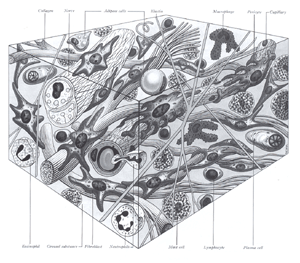 Normally it is thought that our connective tissues provide support to the structure of the body, giving it the shape we have, and provide binding or rigidity to the whole system. However, this view misses many other important functions of our connective tissue and fascial network. Beyond meeting the needs of the body for stability and flexibility, the connective tissue is important for our ability to respond to demands. For example, the CT plays a role in healing the body following certain traumas, such as a broken bone.
Normally it is thought that our connective tissues provide support to the structure of the body, giving it the shape we have, and provide binding or rigidity to the whole system. However, this view misses many other important functions of our connective tissue and fascial network. Beyond meeting the needs of the body for stability and flexibility, the connective tissue is important for our ability to respond to demands. For example, the CT plays a role in healing the body following certain traumas, such as a broken bone.
Connective tissue is a broad term that refers to biological tissues that are used to bind, support, and protect other tissues. CT is extra-cellular, which simply means the tissues are not cells in themselves, but are the materials surrounding and in between cells. Because they are not cellular, many people feel CT is not alive. However, as we will see, CT is very much alive. It responds to stimuli and reacts to keep the body healthy. It is CT that creates and maintains the matrix of the body.
Fascia and connective tissues can be confusing terms. There are many and various cells found inside the body, as shown in the image on the next page. These include nerve cells, fat cells (adipose), blood cells (macrophages, plasma cells, mast cells, and lymphocytes), and blood vessels (capillaries). Weaving their way through all this are fibers, such as collagen and elastin, which are connecting the tissues together. As the name implies, elastin is elastic and lends flexibility while binding the structure. [1] Collagen is relatively inelastic and provides rigidity to the structure. [2] The collection of elastin and collagen can be considered the fascia for this area of the body. Not so obvious, at first, is the ground substance that flows around all the cells. This ground substance is worth studying, as it affects us in many ways, but we will look at this later.
Connective tissues are considered to be of four types. These are:
- Bone
- Blood
- Cartilage
- And all the others
Under “others” we can include, for example, dense CT that includes our tendons and ligaments. When we have no other name to give the CT, fascia is often the term used.
Our connective tissue is what gives us shape and helps to restrain our movements. Bones are the most resistant to movement; cartilage is softer than bone and restrains our activities less strongly. Ligaments, which bind bones together, also act to restrain movement depending upon their location or arrangement surrounding a joint. And then, even less constricting than any of the above but still contributing to restriction of our activities (sometimes more than we would prefer!), there is the fascia (loose connective tissues) that binds and stabilizes the body.
(Next: Bones and Cartilage )
